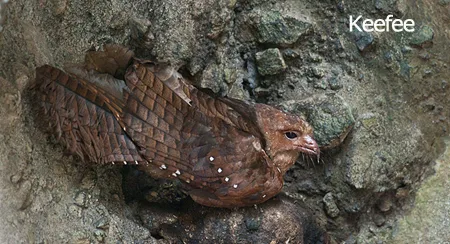
Oilbird
[order] CAPRIMULGIFORMES | [family] Steatornithidae | [latin] Steatornis caripensis | [UK] Oilbird | [FR] Guaracho de Caripe | [DE] Fettschwalm | [ES] Guacharo, Guacharo, Huira Pishco (Ecu) | [NL] Vetvogel
Subspecies
| Genus | Species | subspecies | Breeding Range | Breeding Range 2 | Non Breeding Range |
| Nyctibius | caripensis | ||||
| Steatornis | caripensis | ||||
| Steatornis | caripensis | SA | n, nw, also Panama |
Physical charateristics
It is mainly reddish-brown with white spots on the nape and wings. Lower parts are cinnamon-buff spotted with white. The stiff tail feathers are a rich brown spotted with white on either side.
Listen to the sound of Oilbird
[audio:http://www.aviflevoland.nl/sounddb/O/Oilbird.mp3]
Copyright remark: Most sounds derived from xeno-canto
| wingspan min.: | 90 | cm | wingspan max.: | 100 | cm |
| size min.: | 40 | cm | size max.: | 49 | cm |
| incubation min.: | 32 | days | incubation max.: | 35 | days |
| fledging min.: | 88 | days | fledging max.: | 125 | days |
| broods: | 1 | eggs min.: | 2 | ||
| eggs max.: | 4 |
Range
South America : North, nw, also Panama
Habitat
Oilbird lives in cave ledges during the day. It roosts and breeds in selected caves used since numerous decades of years. They can be found from sea level to 3400 metres of elevation. They need evergreen lowlands and montane forests to feed year round.
Reproduction
Nest is made with regurgitated plant fibres, compacted into a firm paste. It is a cylindrical mound of about 16 inches in diameter. They nest in large colonies, often at good distance into the cave.
Female lays 2 to 4 white eggs, at intervals of 2 to 5 days. Incubation lasts about 32 to 35 days, by both parents, and begins with the first egg laid. Altricial chicks are pinkish, naked and with closed eyes at hatching, and they have an egg tooth.
Chicks are fed by both adults, with oil-fruits, but they grow slowly and they leave the nest at about 110 to 120 days of age.
At 70 days, they are similar to adults, with shorter wings and tail, but their weight reaches about 600 grams, about 50% more than adults. At this time, parents feed them at lower rate, and youngs lose weight, and when they fledge, they have adult weight. They are apparently monogamous and form permanent bonds. Oilbirds are also highly gregarious inside caves. Their bulky nests are built on ledges above cave floor. The clutch size is two to four. Parental care is shared between both adults.
Female lays 2 to 4 white eggs, at intervals of 2 to 5 days. Incubation lasts about 32 to 35 days, by both parents, and begins with the first egg laid. Altricial chicks are pinkish, naked and with closed eyes at hatching, and they have an egg tooth.
Chicks are fed by both adults, with oil-fruits, but they grow slowly and they leave the nest at about 110 to 120 days of age.
At 70 days, they are similar to adults, with shorter wings and tail, but their weight reaches about 600 grams, about 50% more than adults. At this time, parents feed them at lower rate, and youngs lose weight, and when they fledge, they have adult weight. They are apparently monogamous and form permanent bonds. Oilbirds are also highly gregarious inside caves. Their bulky nests are built on ledges above cave floor. The clutch size is two to four. Parental care is shared between both adults.
Feeding habits
Oilbird feeds mainly on fruits of Oil Palm (elaeis) and tropical laurels.
Conservation
This species has an extremely large range, and hence does not approach the thresholds for Vulnerable under the range size criterion (Extent of Occurrence over 20,000 km2 combined with a declining or fluctuating range size, habitat extent/quality, or population size and a small number of locations or severe fragmentation). Despite the fact that the population trend appears to be decreasing, the decline is not believed to be sufficiently rapid to approach the thresholds for Vulnerable under the population trend criterion (>30% decline over ten years or three generations). The population size is very large, and hence does not approach the thresholds for Vulnerable under the population size criterion (over 10,000 mature individuals with a continuing decline estimated to be >10% in ten years or three generations, or with a specified population structure). For these reasons the species is evaluated as Least Concern.

Migration
Some dispersal after breeding, young might be nomadic in their first year.
Distribution map

